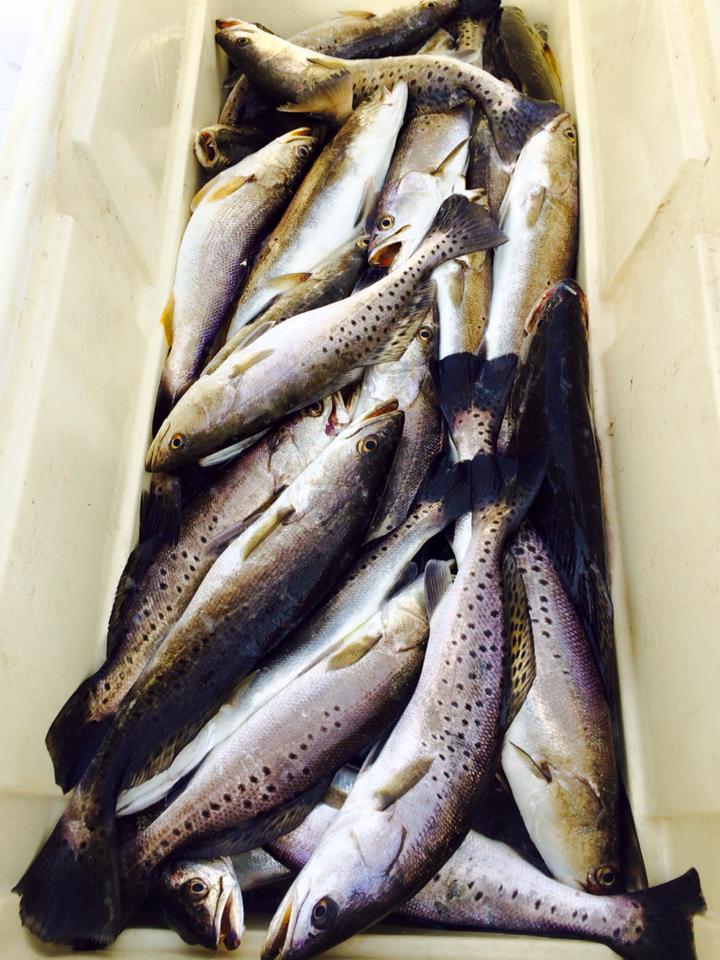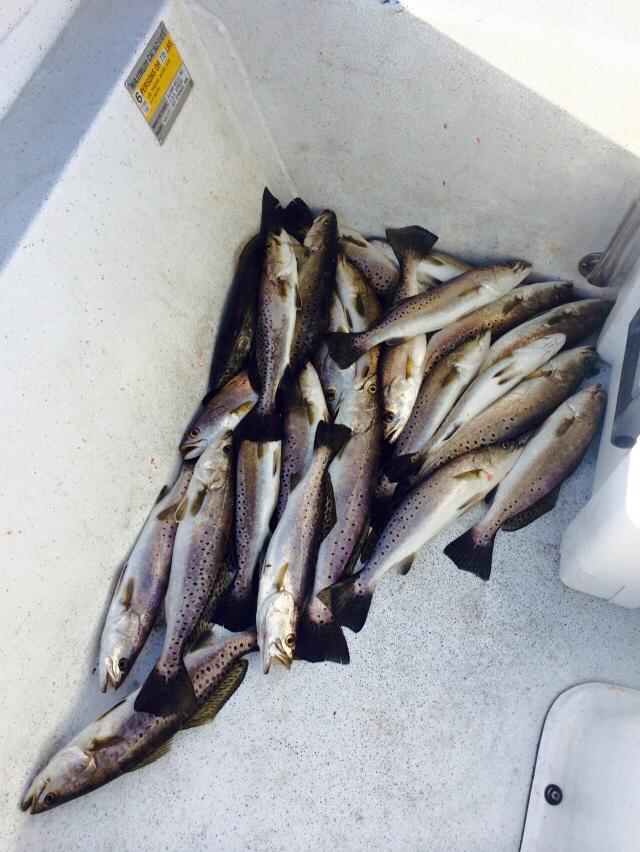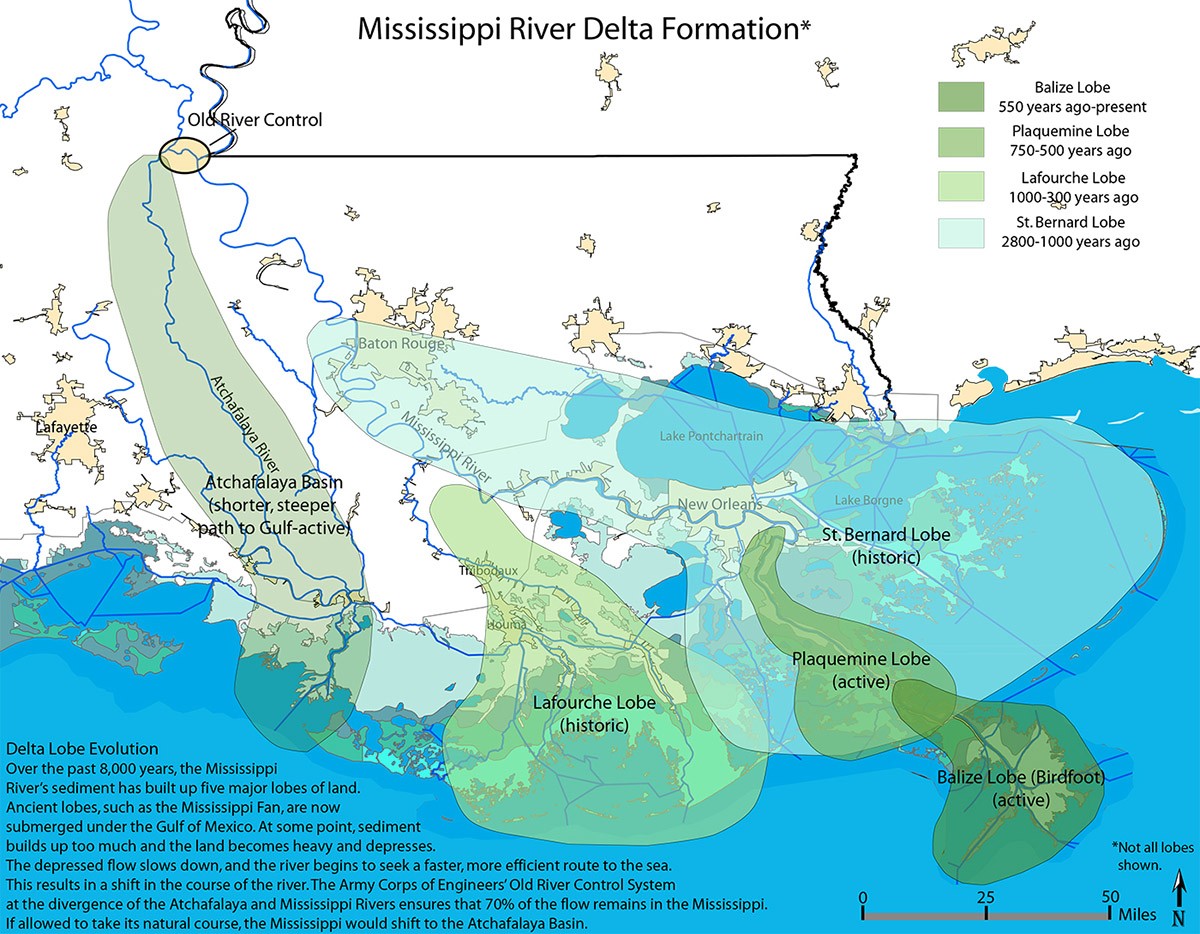The "creel police" from other states wonder why there are dozens too many trout in my dock shots. It's not their fault, they just don't know the incredible fishing we have here in Louisiana.
Two men stood under the faint light of a single fluorescent lightbulb. Crowded by cobwebs, the lightbulb did its best to illuminate the boat slip underneath. They were old Marine Corps buddies and had worked together in Baghdad for a number of years, but their similarities only began there.
They both grew up fishing in Gulf Coast states, one in Louisiana, the other in Florida. Furthermore, they were both charter captains from their respective areas. After what seemed an eternity they were finally launching a boat to go fishing together.
The bone white bay boat floated under its own buoyancy as the hoist groaned to a stop. Comfortable with the moving deck of a freely floating boat, the two of them quickly loaded the cooler, fishing rods and tackle boxes before getting on plane in the morning twilight.
The Pathfinder zipped down Bayou LaLoutre at a brisk 40 miles per hour as the sun began to fully illuminate the surrounding marsh. One brother could sense the other stirring somewhat uncomfortably before asking what was the matter. "When are we going to stop and fish?!", exclaimed the Florida native.
Perplexed, the Louisiana man looked around, then back at his friend before meekly pointing out that they were not to the first fishing spot yet. "But we passed up so many good looking areas!" Assuring him everything was perfectly normal the Louisiana man continued with his plan.
The young Floridian gazed upon the endless expanse of prairie marsh, "It's just so vast."
"It's just so vast."
Those words always stuck with me. The awe on Tater's face and way he said it resonated with me in a way I would never forget.
That day was really fun and productive because we "cross trained" each other. I learned the ways of the Florida inshore angler and he learned some techniques used here in Louisiana. He was really surprised to learn of our creel limits and how they contrasted with those in Florida.
The fishing was really good and he never would have pegged Louisiana for being such a great fishery.
You can't blame him, the majority of pictures of bikini-clad babes wielding speckled trout come from Florida. When one thinks of the stereotypical "salt life" they think of places like Cocoa Beach and Tampa, not Dularge.
For whatever reason that is beyond me, whenever tourists hear "Louisiana" they think of Hurricane Katrina or the BP Oil Spill. I cringe every time someone mentions either because they are so distant in the past.
Katrina made landfall over ten years ago, has Louisiana nothing else that is noteworthy? Yes, she does. One of those things would be her fishing.
Everything from freshwater to offshore fishing she does well, but I am focused on her crown jewel: inshore fishing.
What is so great about Louisiana's inshore fishing?
There's a lot of it.
Louisiana has the most marsh of all the states on the Gulf coast and boasts the highest creel limits for speckled trout, redfish, bass, flounder and more.
It is normal to pull up to a spot in places like Delacroix and catch speckled trout, redfish, bass and more with every cast until the cooler is full. However, let's focus on specks and reds.

Filling a cooler with speckled trout is pretty commonplace in Louisiana.
Comparing Creel Limits
According to regulations in Virginia, you can keep speckled trout that are 14 inches or longer. Additionally, it's illegal to keep more than one speckled trout over 24 inches and it is illegal to have a trout of any size in your possession between March 1st and July 31st (in 2014 only, apparently).
The daily bag limit for specks in Virginia is five per angler.
It's not much different in Florida, where regulations dictate that a speckled trout must be at least 15 inches in length and only one over 20 inches can be kept in a daily bag limit of 4 to 6, depending on the zone you are in.
Now compare this to Louisiana, where our minimum size limit is 12 inches, no slot size exists and our daily bag limit is 25 specks per angler.
If you grew up inshore fishing in Louisiana this is not surprising, but apparently this is not household information for inshore anglers hailing from outside the Bayou State.
It is not just speckled trout. Our generous creel limits extend to redfish, white trout, black drum and flounder.
Let me touch on a few things in the next section as to why this chasm exists between our fishery and others before every keyboard-environmentalist hits the panic button.

Often the trout bite can be so intense there is no time to throw them in the cooler.
What makes Louisiana's inshore fishing so great?
Short answer: We have the Mississippi River.
Long answer: See, the Mississippi River has spent ages building up this massive wetland that serves as an excellent breeding ground for everything from largemouth bass to yellowfin tuna.
She would flow in one direction for a few thousand years, build a delta before abandoning it and flowing in a new direction, creating a new delta.
Knowledge Bomb Bodies of water like Bayou LaLoutre, Bayou Terre aux Beouf and Oak River are all places where the Mighty Mississippi once flowed, delivering land-building sediment.
Because of her action, we have a massive coastline with immense tidal depth to create a vast estuary with every kind of salinity. If you are not sure, then just look at Google Earth and follow along.

More Real Estate
The famed Laguna Madre in south Texas is well known for its excellent fishing opportunities. That area is roughly 609 square miles. Hopping on Google Earth and measuring off the marsh northeast of the Mississippi River Gulf Outlet in Louisiana yields an area in excess of 700 square miles.
(Go do it for yourself. I could show it to you but this is a practical exercise that will give you, the reader, a better appreciation of what Louisiana is all about.)
Guys and gals, that is just one little area in Louisiana.
That does not include Hopedale, Delacroix, Lafitte, Westwego, Grand Isle, Fourchon and much more. Louisiana's general shoreline is only slightly longer than that of Texas, coming in at 397 miles over 367 miles.
However, that's not taking in the shoreline of every lake and lagoon. When you account for tidal shoreline Texas comes in at a staggering 3,359 miles. Louisiana meets this with an astronomical 7,721 miles of shoreline. Florida, however, beats them both at 8,436 miles of tidal shoreline.
Tidal Depth is Key
So why doesn't Florida have more specks and reds? There is more to this equation than miles of tidal shoreline.
As stated earlier, our marsh has deeper tidal depth than any other place.
What is tidal depth? I use "tidal depth" to describe how far one has to go to get from solid land (read: the marina) to the Gulf of America. This factor varies across Louisiana, but most places you are looking at a boat ride in excess of 45 miles.
Tidal depth is important because it creates the diverse real estate inshore denizens need to prosper in. For example, in Delacroix you can literally go from straight freshwater to all-out saltwater and still launch from the same place.
Different Tides
The Mighty Mississippi plays a role in slowing Louisiana's inshore tide down to a lower diurnal tide. This tide is much easier on wildlife and conducive to creating more baby specks and reds. I cover the nature of our Louisiana tide extensively in Mastering the Tide.
Turbid Water
Turbidity is a ten dollar word describing how murky water is.
Rivers fed by runoff (i.e. Mississippi River, Pearl River, Amite, etc.) is extremely turbid, light barely penetrates it. Conversely, water in dive destinations like Cozumel, Mexico is not turbid at all and light passes freely.
I believe the moderate turbidity of our inshore waters gives juvenile specks and reds a chance at life. They can avoid being eaten pelicans and great blue herons.
So what are we to do?
Go fishing! If you live in Louisiana you should go fishing. If you don't, then come visit and go fishing with us! This is going to sound crazy, but there are not as many licensed Louisiana anglers as you would guess.
We have a population under 5 million and Florida has about four times that and nearly twice as many licensed anglers. My point is, we have plenty of room to spare! So drag your boat down, get a Louisiana fishing license, and be sure to check the latest intel on LAFB Elite's Community.

I don’t know anyone or any outlet that will agree with anyone who believes that there’s a stronger fighting fish, pound for pound than the red drum or redfish. It doesn’t matter if it’s a species that is across the world, the red drum are pretty much known by all to be the most powerful inshore species anywhere. Furthermore the marshes and flats in Louisiana can easily fill an ice chest with redfish (5) black drum (5) specks (25) flounder (10) bass (depending on area, some places don’t have a size or daily bag limit) blue catfish, channel catfish, flathead catfish, and galftop catfish/sail catfish, white trout (no size/bag limit) sheepshead, mangrove snapper, triple tail, croaker, channel mullet, alligator garfish and bowfin/choupique. I may be wrong about some limits and left off some species because there are too many to try to think of.
Without having much experience in other states I can say that tomorrow I’ll be on the water fishing around Galliano in the Sulphur Mine as it’s called. It’s mostly salt water that’s really considered brackish water and I catch bass there regularly. My targets are the beautiful reds I regularly limit on early enough to chase birds and trout. We don’t have much trouble finding 5 reds that average about 24″ and regularly release fish from 27″ to 34″ or so. Nothing I’ve done yet in a boat can compare with sight fishing reds! When they’re in very shallow water and they have parts of their back and tail sticking out of the water as they cruise back and forth on grass flats gorging on minnows and crustaceans. When you can cast their way and miss your mark by 6-8′ but the particular red sees the bait or hears the water when the bait hits and splashes. That red will often stop digging or chasing bait and explode towards the bait leaving a cloud of mud in its wake. When you are watching this from a 26″-30″ red as it gets extremely violent when it arrives, always arriving with a purpose and destroying your lure or bait it’s hard to wait to set the hook but it’s best to wait until you feel the bite. Then it’s on! It’s why the tournament fisherman love Louisiana redfishing because those slot reds are simply heavier in Louisiana than Florida. Our 1ft or less tidal fluctuations are not seen many places in the world, these fish aren’t constantly moving to stay with the food source or have enough water.
The specks we usually enjoy catching range from around 14″ up but usually 14″-20″ trout are the norm. I live to redfish but few things are more fun than catching 20-25 specks all 2lbs and bigger.
Not knowing what to expect when I cast a live minnow on the bottom or a live shrimp under a popping cork out in the cuts or near the grass beds is what makes it unlike anything most people can do at their favorite fishing places. I might catch an undersized red, a rat red or maybe my rod will get tested when a 40″ bull red picks up the bait and runs! That may mean I’ll be in a battle for 30 minutes or longer but it’s what makes the slogan on our license plate so true, “Sportsman’s Paradise” and if any other state could compete I’d think Texas, I don’t consider Florida a contender just because you can catch snook in crystal clear water and go to Disney World. If you find me in Florida I’m probably around the bikinis but if I’m fishing I’ll probably be targeting huge Florida Largemouth Bass! The one species in Florida that is noteworthy is those huge bass that are known simply as, “Florida Bass.”
You’re welcome, Marty. Thanks for commenting!
Thanks for sharing, wonderful post.
It’s all good!
I didn’t think your comment came off as rude, because I know much is lost in translation over the Internet.
Rather, I think you came as being passionate and taking inshore fishing seriously, treating it as something more than just a “drinking sport”.
Tight lines!
Thanks for being respectful. Believe it or not actually grew up flats fishing in louisiana, and moved to florida because in my opinion the fishing was superior, others I know have done the same and agree.
Listen, louisiana is unsurpassed for redfish that is unquestionable, but a permit will outfight a redfish and is more wary, a snook has more power on it’s first run and will jump like a bass, and a bonefish pound per pound is unsurpassed for it’s runs as far as flats species are concerned.
If louisiana possessed these species i might agree with you, but florida’s 3 extra species gives it a definite edge in my mind. I couldn’t stand not being able to fish for snook or permit.
In my mind florida deserves it’s reputation as the number one saltwater fishing state, which many from around the world would agree. As just one example, check out what the safc pro staff had to say at this link I personally think they ranked Louisiana to low though.
It’s all subjective honestly, some will prefer one state to another for various reasons, but for the reason i’ve stated i believe florida to be king, surpassing my home state.
One last thing, my first comment now that i’ve re-read it came of as kinda rude, and if you saw it this way I deeply apologise.
Hey there (I’d say your name, but you didn’t post it), I’m glad you took the time to comment and share your feelings.
I’d prefer you do that than not say anything else at all.
Sure, Louisiana doesn’t have those species. You are correct.
But man, if you haven’t fished Louisiana then you really haven’t seen what’s here and cannot possibly make a comparison.
It’s not even close.
Consider that out-of-state redfish tournament trails come to Louisiana, but no Louisiana tournaments go out-of-state.
Florida guides leave Florida to come here and fish. There’s tons of them.
Some just move here and become residents.
When people want to catch fish, and have plenty of real estate to do it in, they come to Louisiana. Every time.
Florida does have good fishing, no doubt. But folks usually go there because there’s something else for the wife and kids to do while they’re out fishing, like the beach.
There are few beaches in Louisiana, and some of the destinations anglers go to don’t have much else for the family to do.
So, for those reasons, and all the ones I listed in this article, I respectfully disagree.
You don’t even have any snook, bonefish, permit etc. but somehow your flats fishing is superior? Heck, we’ve even got cobia on the flats here in florida! Louisiana is a great flats fishing state but florida is and will always be no.1